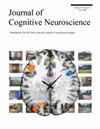探究音步三部律中响亮优先原则的神经基础
IF 3.1
3区 医学
Q2 NEUROSCIENCES
引用次数: 0
摘要
对节奏模式的感知对于识别口语中的单词至关重要,但这些模式是如何在大脑中表现出来的仍不清楚。在这里,我们测试了一种假设,即节奏模式是由与语音信号中这些模式的时间调制相锁定的神经活动编码的。为了验证这一假设,我们分析了交替音节长序列诱发的脑电图,这些交替音节被声学处理成一系列不同的英语节奏组。我们发现,每个序列的音节和编组速率下的脑电图幅度明显高于噪声基线,这表明神经对音节和节奏编组的解析是在不同的时间尺度上进行的。与每个时间尺度相关的头皮地形之间的分布差异表明,音节和编组的神经分割之间存在进一步的机理分离。此外,我们还观察到,神经对大音节的追踪比神经对小音节的追踪更稳健,而在英语等三音节语言中,大音节与节奏分组的开始相关。进一步的引导和大脑行为分析结果表明,对节奏模式的感知受神经信号中分组交替幅度的调节。这些研究结果表明,在英语等以重音为基础的语言中,节奏模式的时间编码得到了语音信号中与语言相关的时间规律性的支持。本文章由计算机程序翻译,如有差异,请以英文原文为准。
Investigating the Neural Basis of the Loud-first Principle of the Iambic–Trochaic Law
The perception of rhythmic patterns is crucial for the recognition of words in spoken languages, yet it remains unclear how these patterns are represented in the brain. Here, we tested the hypothesis that rhythmic patterns are encoded by neural activity phase-locked to the temporal modulation of these patterns in the speech signal. To test this hypothesis, we analyzed EEGs evoked with long sequences of alternating syllables acoustically manipulated to be perceived as a series of different rhythmic groupings in English. We found that the magnitude of the EEG at the syllable and grouping rates of each sequence was significantly higher than the noise baseline, indicating that the neural parsing of syllables and rhythmic groupings operates at different timescales. Distributional differences between the scalp topographies associated with each timescale suggests a further mechanistic dissociation between the neural segmentation of syllables and groupings. In addition, we observed that the neural tracking of louder syllables, which in trochaic languages like English are associated with the beginning of rhythmic groupings, was more robust than the neural tracking of softer syllables. The results of further bootstrapping and brain–behavior analyses indicate that the perception of rhythmic patterns is modulated by the magnitude of grouping alternations in the neural signal. These findings suggest that the temporal coding of rhythmic patterns in stress-based languages like English is supported by temporal regularities that are linguistically relevant in the speech signal.
求助全文
通过发布文献求助,成功后即可免费获取论文全文。
去求助
来源期刊
CiteScore
5.30
自引率
3.10%
发文量
151
审稿时长
3-8 weeks
期刊介绍:
Journal of Cognitive Neuroscience investigates brain–behavior interaction and promotes lively interchange among the mind sciences.

 求助内容:
求助内容: 应助结果提醒方式:
应助结果提醒方式:


